
The Cathedral Church of St. Paul is the cathedral church of the Episcopal Diocese of Michigan. In 1824 its congregation formed as the first Episcopal and first Protestant church in Michigan Territory.

Carpenter Gothic, also sometimes called Carpenter's Gothic or Rural Gothic, is a North American architectural style-designation for an application of Gothic Revival architectural detailing and picturesque massing applied to wooden structures built by house-carpenters. The abundance of North American timber and the carpenter-built vernacular architectures based upon it made a picturesque improvisation upon Gothic a natural evolution. Carpenter Gothic improvises upon features that were carved in stone in authentic Gothic architecture, whether original or in more scholarly revival styles; however, in the absence of the restraining influence of genuine Gothic structures, the style was freed to improvise and emphasize charm and quaintness rather than fidelity to received models. The genre received its impetus from the publication by Alexander Jackson Davis of Rural Residences and from detailed plans and elevations in publications by Andrew Jackson Downing.

Saint Mark's Episcopal Cathedral in Minneapolis is one of two cathedrals in the Episcopal Church in Minnesota. The church was founded in 1858 and designated as a cathedral in 1941. Its current building dates from 1910.

Grace Episcopal Church located at 1011 North 7th Street in Sheboygan, Wisconsin, is an Anglo-Catholic parish of the Episcopal Church, part of the Diocese of Fond du Lac.
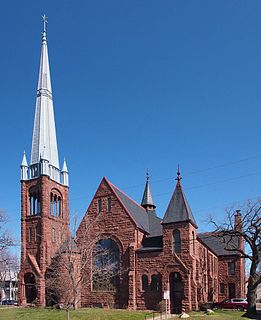
The First Congregational Church is a historic church building in the Marcy-Holmes neighborhood of Minneapolis, Minnesota, United States, built in 1886. It is constructed of red sandstone in Gothic-Romanesque style, featuring round-arched windows and semi-circular rows of pews. When initially completed the building was in a residential neighborhood surrounded by mansions of prominent citizens and merchants of the time, including Octavius Broughton, Woodbury Fisk, Thomas Andrews, Horatio P. Van Cleve, William McNair, and John Dudley. Over time the neighborhood changed to a more transient population, dominated by students attending the University of Minnesota. Architect Warren H. Hayes (1847-1899) was Minneapolis' leading designer of churches in the 19th century, having designed the Calvary Baptist Church, Fowler Methodist Episcopal Church, and Wesley Methodist Episcopal Church, as well as the Central Presbyterian Church in Saint Paul.

The historic Calvary Episcopal Church was established in 1857 and is located at 821 South 4th Street Louisville, Kentucky. This stone gothic church was built in Old Louisville in 1888 and is listed on the National Register of Historic Places. The church is a member parish of the Episcopal Diocese of Kentucky.

St. Joseph's Episcopal Church, now known as St. Matthew's-St. Joseph's Episcopal Church, is a historic Episcopal church located at 8850 Woodward Avenue in Detroit, Michigan, and is part of the Episcopal Diocese of Michigan. It was added to the National Register of Historic Places in 1982.
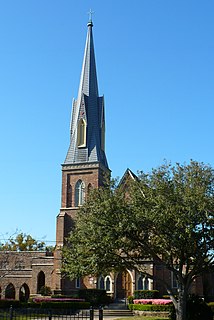
Trinity Episcopal Church is a historic church in Mobile, Alabama, United States. It was the first large Gothic Revival church built in Alabama. The building was designed by architects Frank Wills and Henry Dudley.

St. Philip's Episcopal Church is an historic Episcopal church located in the High Hills of Santee, in the antebellum summer resort community of Bradford Springs in Lee County, South Carolina, about six miles north of Dalzell.

The Gethsemane Evangelical Lutheran Church is a church located at 4461 Twenty-Eighth Street in Detroit, Michigan. It was designated a Michigan State Historic Site in 1980 and listed on the National Register of Historic Places in 1982. The building now houses the Motor City Missionary Baptist Church.

Edward Townsend Mix was an American architect of the Gilded Age who designed many buildings in the Midwestern United States. His career was centered in Milwaukee, Wisconsin, and many of his designs made use of the region's distinctive Cream City brick.

The Methodist Episcopal Church is a historic church and parsonage at 61 East Putnam Avenue in Greenwich, Connecticut. Built in 1868-69 for a Methodist congregation established in 1805, the church is a fine local example of Carpenter Gothic architecture, and the parsonage, built in 1872, is a good example of Italianate architecture. The property was listed on the National Register of Historic Places in 1988. The congregation is affiliated with the United Methodist Church.

This is a list of the National Register of Historic Places listings in Swift County, Minnesota. It is intended to be a complete list of the properties and districts on the National Register of Historic Places in Swift County, Minnesota, United States. The locations of National Register properties and districts for which the latitude and longitude coordinates are included below, may be seen in an online map.
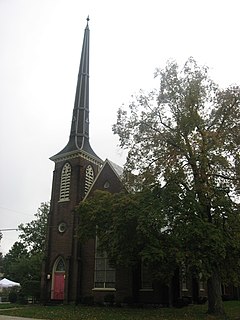
Bethel African Methodist Episcopal Church of Monongahela City is a historic church at the junction of 7th and Main Streets in Monongahela City, Pennsylvania.

Gethsemane Lutheran Church is a historic Lutheran church in downtown Austin, Texas. Designated as a Recorded Texas Historic Landmark and listed on the National Register of Historic Places, the building currently holds offices of the Texas Historical Commission.
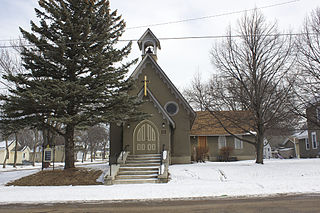
Gethsemane Episcopal Church is a historic Episcopal church building in Appleton, Minnesota, United States. It was built in 1879 during the episcopate of pioneer Bishop Henry Benjamin Whipple. It was originally a wooden-frame structure with the board and batten walls and lancet windows typical of Carpenter Gothic style. Around 1920 the interior and exterior walls were plastered over, which greatly changed its appearance and obscured its Carpenter Gothic origin. Over the years additions were made to the building and a basement was added.

The St. Michael's Episcopal Church in Anaheim, California, also known as The Chapel at St. Michael's Episcopal Church, is a historic church at 311 West South Street. It was built in 1876 and was added to the National Register of Historic Places in 2004.

St. Mark's Episcopal Chapel is a small Gothic Revival chapel in Corinna Township, Minnesota, United States, built in 1871. It was listed on the National Register of Historic Places in 1979 for having local significance in the themes of architecture and religion. It was nominated as a well-preserved example of a board and batten Gothic Revival parish church.
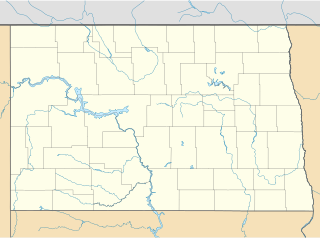
Gethsemane Episcopal Cathedral is an Episcopal cathedral in Fargo, North Dakota, United States. It is the seat of the Diocese of North Dakota.

The former St. Matthias' Episcopal Church, now known as the Dietz United Methodist Church, is a historic church in Omaha, Nebraska. It was built in 1888 for the Episcopal Church, and it was designed in the Romanesque Revival and Gothic Revival styles by architect John H.W. Hawkins. It was acquired by the United Methodist Church in 1920. It has been listed on the National Register of Historic Places since November 23, 1980.

























